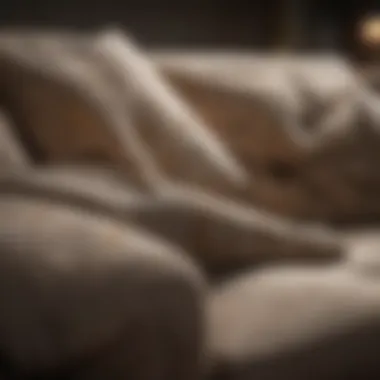A Comprehensive Guide to Cleaning a Used Fabric Couch


Intro
Cleaning a used fabric couch is a task that requires attention to detail and knowledge of various fabrics and cleaning methods. Many individuals overlook the significance of maintaining their upholstery, leading to wear and tear that diminishes the couch's overall aesthetic appeal. This guide aims to provide a thorough understanding of effective cleaning methods tailored for different fabric types, along with essential tools and techniques needed for successful maintenance. Knowing how to care for your couch can extend its lifespan and maintain its beauty.
Assessing the couch’s condition is the first step. It’s important to understand the fabric type and any stains or damage present. This foundational knowledge will help in selecting the right cleaning solutions, ensuring that methods employed are suitable for the material.
The process does not stop at cleaning; regular maintenance is critical. Simple tasks such as vacuuming and spot cleaning can prevent build-up of dirt and grime. Additionally, periodic deep cleaning can help maintain hygiene and integrity of the couch.
In the sections that follow, we will delve into various types of fabrics, cleaning methods, recommended tools, and necessary maintenance practices. This structured approach will empower you with the knowledge to transform and care for your used fabric couch effectively.
Understanding Fabric Types
Before embarking on the cleaning process, familiarizing oneself with different fabric types is crucial. Fabrics such as cotton, linen, leather, microfiber, and synthetic blends each require specific care regimens. Here’s a brief overview:
- Cotton: Softer and can often be machine washed. However, it may shrink or fade.
- Linen: Delicate and prone to wrinkling, requiring gentle cleaning solutions.
- Leather: Needs special care; regular conditioning is essential to prevent cracking.
- Microfiber: Durable and resistant to stains, but must be cleaned with specific cleaners to preserve texture.
- Synthetic Blends: Often robust and easy to clean with standard cleaning solutions.
Knowing these characteristics is vital to avoid damaging the fabric while cleaning.
Assessing Couch Condition
Evaluate the couch's overall condition. Look for stains, dirt accumulation, or signs of wear. This assessment helps determine the level of cleaning required. Minor stains might need spot treatment, while a more general grime build-up could necessitate a deep clean.
Additionally, inspect the seams and any zippers. Damage in these areas could affect the cleaning process. Sometimes, it is essential to make repairs prior to cleaning to avoid further damage.
Cleaning Methodologies
Once the fabric type and couch condition are assessed, it’s time to choose the appropriate cleaning methodology. Different cleaning methods can include:
- Vacuuming: Start by removing loose dirt and debris with a vacuum equipped with an upholstery attachment. This first step is crucial as it prevents dirt from becoming ingrained during wet cleaning.
- Spot Cleaning: Use a suitable stain remover tailored to your fabric type. Always perform a patch test in an inconspicuous area to check for adverse reactions before applying a cleaner more widely. Blot, do not rub, to avoid making the stain worse.
- Deep Cleaning: For more thorough cleaning, consider steam cleaning or professional services tailored to your fabric type. Use cleaning solutions that are pH balanced to avoid damage.
Important: Always check the manufacturer's labels for specific cleaning instructions associated with your couch.
Recommended Cleaning Tools
Using the right tools is integral to effective couch cleaning. Some tools to consider include:
- Upholstery Cleaner: Choose one that is compatible with your fabric.
- Soft Brush: Use designed brushes that won’t damage the fabric fibers.
- Lint Rollers: Handy for removing pet hair quickly and efficiently.
- Steam Cleaner: Great for deep cleaning without harsh chemicals.
Properly selected tools contribute greatly to achieving a clean and well-maintained couch.
Regular Maintenance Tips
Maintaining a used fabric couch can be simple with consistent upkeep. Here are a few tips:
- Vacuum Weekly: Regularly remove dust and dirt to prevent buildup.
- Prompt Treatment for Spills: Attend to spills immediately to avoid stains setting in.
- Use Fabric Protectors: Apply fabric protectors to guard against future stains.
- Rotate Cushions: Regularly rotate and flip cushions to ensure even wear.
By following these practices diligently, the couch can remain in good condition for an extended time, preserving its appearance and functionality.
Understanding Fabric Types
Fabric types play a critical role when cleaning a used fabric couch. Knowledge of the materials helps in selecting appropriate cleaning methods. Each fabric type has unique characteristics, which influence its durability, maintenance requirements, and the cleaning processes that can be safely employed. Understanding fabric types can minimize the risk of damage while effectively removing dirt and stains, ensuring the longevity of the couch.
Natural vs. Synthetic Fabrics
Natural fabrics, such as cotton, linen, and wool, are made from plant or animal fibers. They tend to be softer and more breathable. However, they can absorb stains and moisture more easily. Cleaning these fabrics usually requires gentler methods to avoid damage or shrinkage.
On the other hand, synthetic fabrics like polyester, nylon, or acrylic are derived from petroleum products. They are often more durable and stain-resistant. This durability makes them suitable for a variety of cleaning methods, including harsher chemicals. However, they can show wear over time and may require special care to maintain their appearance.
Common Fabric Blends
Blended fabrics combine natural and synthetic fibers to achieve specific performance characteristics. For instance, a cotton-polyester blend can provide the softness of cotton with the durability of polyester. Understanding these blends is vital. Each blend has its own cleaning requirements based on the proportions of each material.
When you have a fabric blend, consult tags or manufacturer guidelines to determine the best cleaning method. Some common blends include:
- Cotton-Polyester
- Linen-Viscose
- Wool-Nylon
This knowledge helps in applying correct cleaning techniques, whether it involves soft brushes or special cleaning solutions.


Identifying Couch Fabric
Identifying the couch fabric is crucial before embarking on a cleaning journey. Many couches don’t have labels or tags, making this task a challenge. To identify the fabric, consider texture, appearance, and stretching. Natural fabrics typically feel softer or cooler than synthetics. Use a burn test to closely determine fabric types: burn a small sample (if possible) and observe the smell and ash characteristics.
Make sure to analyze seams and stitching. Thicker threads often indicate durable synthetic fabrics, while finer threads could point to natural fibers. Knowing the fabric type ensures the application of suitable cleaning solutions, preventing potential mishaps during the cleaning process.
Understanding the fabric type is a foundational step in ensuring effective cleaning without causing damage.
By grasping the differences between these types of fabrics and recognizing the couch’s specific material, you prepare yourself for an effective cleaning experience.
Pre-Cleaning Assessment
A pre-cleaning assessment plays a crucial role in effectively cleaning a used fabric couch. This process not only prepares the fabric for cleaning but also helps identify specific issues that need attention. By conducting a thorough assessment, you ensure that you can tailor your cleaning approach to the fabric type and condition of the couch. This will lead to better cleaning results and protect the integrity of the upholstery.
Inspecting for Stains
Begin by examining the couch for visible stains. Different stains require different approaches for effective removal. Common types include food and beverage spills, pet accidents, and ink marks. Using a flashlight can help highlight stains that may be hard to see under regular lighting.
Make note of the stain locations and sizes because this information will guide your cleaning strategy. It is also sensible to check if any stains have set in or become permanent. Prompt action can prevent stains from becoming more difficult to remove. Stain removal products can vary in effectiveness based on the stain type, so knowing what you're up against is essential.
Checking for Damage
Next, gently run your hands over the fabric to feel for any damage. Look for frayed threads, worn areas, or signs of excessive fading. Damage can compromise the cleaning process and may require special attention. If you find any damage, consider addressing this first, as certain cleaning methods can worsen existing problems.
Additionally, inspect the seams and stitching. If these areas show signs of wear, cleaning might cause further unraveling. For serious structural damage, consider consulting a professional before proceeding with cleaning.
Smell Test
Lastly, a smell test is important to assess hidden issues. Odors can come from various sources, such as pet dander, mold, or old food stains. Smelling the couch can give you insight into potential problems that are not visible to the eye.
If you detect unpleasant odors, it may be necessary to treat the couch additionally for these issues. Identify the source of the odor to decide on the best cleaning products to use. For example, mild fabric fresheners can mask minor odors, but deep cleaning may be needed for long-standing smells.
Remember, a well-done pre-cleaning assessment can save time and effort during the actual cleaning process. It sets the stage for a thorough and successful cleaning experience, ensuring that your fabric couch can remain in great shape.
Gathering Cleaning Supplies
Gathering appropriate cleaning supplies is a critical beforehand step that sets the tone for the entire cleaning process of a fabric couch. Without proper tools and solutions, you risk ineffective cleaning that could lead to further damage or stains. The right supplies can make the task easier, more efficient, and can significantly enhance the final results.
Essential Tools
To begin, it is important to have essential tools ready. These supplies are fundamental for tackling various aspects of couch cleaning:
- Vacuum Cleaner: A vacuum cleaner with upholstery attachments will help remove loose dirt, dust, and hair from the fabric. The tool enables you to access crevices and under-cushion areas.
- Soft Brushes: Soft-bristled brushes are advantageous for lifting dirt without damaging the fabric. They can effectively agitate the fibers of the upholstery to release trapped particles.
- Microfiber Cloths: These are versatile and can be used for both wet and dry cleaning. They for trapping dust and moisture very effectively, making them essential for detailed cleaning.
- Spray Bottles: Clear, empty spray bottles are useful for diluting cleaning solutions or creating homemade cleaners.
The selection of tools is significant, as using the right equipment helps avoid additional stains while improving cleaning effectiveness.
Choosing the Right Cleaning Solutions
Equally essential is the selection of appropriate cleaning solutions. Not all fabrics respond well to the same cleaning agents. Users need to consider the following:
- Manufacturer Recommendations: Always check the care label on the couch. Most brands indicate suitable cleaning methods and solutions.
- Type of Stain: Specific stains often require unique solutions. For instance, oil-based stains need a solvent, while water-based stains can be treated with water.
- pH-balanced Cleaners: Opting for pH-balanced agents is crucial as they clean effectively without damaging the fabric.
Reading up on the cleaning solutions will help in making informed choices, allowing for better outcomes in the cleaning process.
Eco-Friendly Alternatives
In today's world, being environmentally conscious should be a priority. Eco-friendly cleaning alternatives are increasingly available and offer effective cleaning without harmful chemicals. Consider:
- Vinegar and Water Solution: A simple mixture of vinegar and water can help lift stubborn stains and eliminate odors.
- Baking Soda: This versatile product works wonders for absorbing odors and can be sprinkled on the fabric before vacuuming.
- Castile Soap: A plant-based soap, it is gentle on fabrics and effective against stains.
Using such alternatives not only protects the environment but can also be safer for households with pets or children. Making the choice of eco-friendly cleaning supplies creates a positive impact in multiple ways.
"The right tools and cleaning solutions can make all the difference in restoring your fabric couch to its former glory."
Thus, take your time in selecting the proper supplies. Ensuring you have the tools and solutions at hand will positively influence the success of your cleaning efforts.
Preparing the Couch for Cleaning
Cleaning a used fabric couch requires careful preparation. Properly getting your couch ready for the cleaning process improves results and helps avoid damage. The couch absorbs many substances over time, such as dirt, oils, and allergens. Preparing your couch ensures that you can address these issues effectively.


Removing Cushions and Covers
Take off the cushions and any removable covers. This step allows you to clean each part separately. Often, the cushions collect more debris compared to the main frame. By removing them, you can reach areas that are usually neglected. Check the care label for cleaning instructions. Some covers might be machine washable, while others require spot cleaning.
Vacuuming the Couch
Vacuuming is essential before deep cleaning. Use an upholstery attachment to remove dust and loose debris. Pay attention to seams and crevices, as dirt often hides in these areas. Vacuuming will prevent dirt from mixing with your cleaning solution. Without this step, dirt might become embedded deeper into the fabric. A clean surface makes any cleaning solution work more effectively.
Testing Cleaning Solutions
Before applying any cleaning solution to the couch, it is critical to test it. Choose a discrete area, such as the side or the back. Apply a small amount of the solution and wait for a few minutes to see how the fabric reacts. Look for any discoloration or change in texture. This precaution helps prevent potential damage to the main areas of the couch. Ensure any cleaning solution is compatible with the fabric type identified in earlier sections.
"Preparation is key to a successful cleaning experience. Taking these steps can save time and effort later on."
By understanding these three critical elements, you can prepare your used fabric couch for effective cleaning. Each step plays a vital role in the overall outcome, ensuring that your couch looks refreshed and clean.
Cleaning Techniques
Cleaning techniques are critical for revitalizing a used fabric couch. These methods not only enhance the appearance of the couch, but also extend its lifespan. Proper cleaning can prevent deterioration and preserve the original quality of the materials. Effective cleaning techniques differ based on the specific issues that need addresssing, whether it's a simple spot or extensive soiling. Familiarity with these methods is beneficial, as it helps tackle cleaning challenges efficiently.
Spot Cleaning Stains
Spot cleaning is paramount when dealing with stains on your fabric couch. This technique allows for immediate removal of unwanted marks before they set in. Common stains include food, beverage spills, or pet accidents. To successfully spot clean, first identify the type of stain. Apply a gentle cleaning solution specific to that stain type. Use a clean cloth or sponge to blot the area, avoiding vigorous rubbing to prevent fabric damage.
- Identify the stain: Knowing what has caused the stain can significantly influence your cleaning approach.
- Choose an appropriate cleaner: Ensure that the cleaner is suitable for fabric type to avoid discoloration.
- Blot, don't rub: Blotting helps absorb the stain without spreading it further.
Remember, acting quickly can often prevent permanent stains from forming.
Deep Cleaning Methods
Deep cleaning methods are essential for a thorough cleanse of your couch. Unlike spot cleaning, deep cleaning addresses overall dirt buildup, allergens, and microbes. This method might involve shampooing the fabric, using specialized upholstery cleaners, or implementing a combination of techniques.
- Shampooing: Fabric-friendly upholstery shampoos can effectively lift embedded dirt.
- Washing Covers: If removable, washing covers in a washing machine offers an effective and simple method.
- Rinsing & Drying: Ensure proper rinsing to remove any detergent residue, which can attract more dirt.
Deep cleaning should ideally be performed at least once a year to maintain a clean and hygienic couch.
Using Steam Cleaners
Steam cleaners represent an advanced option for cleaning fabric couches. This method uses heat and moisture to break down dirt and grime without harsh chemicals. Steam cleaning can also help eliminate bacteria and dust mites, making it a suitable choice for households with allergy sufferers.
- Advantages: Steam cleaning is effective at sanitizing and refreshing upholstery.
- Precautions: Always read the manufacturer's guidelines regarding fabric types to avoid damage.
- Follow-up Care: Allow sufficient drying time post-cleaning, as excess moisture can lead to mold or mildew.
For maximum effectiveness, combine steam cleaning with routine maintenance. Being proactive in cleaning will ultimately ensure your couch remains in good condition.
Drying and Post-Cleaning Care
Drying and post-cleaning care are critical steps in the process of cleaning a fabric couch. Effective drying not only prevents moisture buildup but also minimizes the risk of mold and unpleasant odors. The techniques you choose for drying impact the final appearance and longevity of the fabric. This section will explore various aspects of drying and provide essential care tips following the cleaning process.
Air Drying vs. Using Towels
When it comes to drying a fully cleaned couch, you have a choice between air drying and using towels. Air drying is often the preferred method as it allows for natural evaporation without additional moisture being introduced. Placing the couch in a well-ventilated area can greatly enhance the effectiveness of this method. Positioning fans or opening windows can be beneficial, encouraging airflow.
On the other hand, using towels can speed up the drying process. After cleaning, using fresh, absorbent towels to blot excess moisture can be helpful. This method draws out dampness quickly but requires caution. If towels are too wet themselves, they can introduce more water. Ensure your towels are dry and press them gently against the fabric, absorbing moisture without rubbing, to prevent any potential damage.
Reassembling the Couch
Once the couch has dried sufficiently, it is time to reassemble any removable cushions or covers. This step is straightforward but should be approached carefully. Make sure to follow the original arrangement. If your couch has detachable parts, such as removable covers or separate cushions, check that they are completely dry before placing them back on the frame. Reassembling while still damp can lead to a musty smell and create an environment conducive to mildew.
Take a moment to fluff and adjust cushions appropriately, ensuring an even shape and comfort level. This practice helps restore the physical appearance of the couch while also maintaining its functional integrity.
Applying Fabric Protectors
After cleaning and reassembly, considering the application of fabric protectors is wise. These protectors can act as a barrier against future stains and dirt. When selecting a fabric protector, it is important to choose one designed specifically for your type of couch fabric. Follow the manufacturer's instructions carefully for application.
Spraying or applying a thin layer of protector helps seal the fibers and can enhance the fabric's resistance to spills. This proactive approach not only enhances durability but also simplifies future cleaning. Regular application can prolong the life of your couch, keeping it looking fresh.
The right post-cleaning care ensures that your investment in a used fabric couch returns its full value.
In summary, drying and post-cleaning care should not be overlooked. The methods used to dry the couch, proper reassembly techniques, and the application of protectors all play important roles in maintaining the couch's condition. By taking these steps seriously, you ensure that your efforts in cleaning pay off, keeping your couch looking good for years to come.


Regular Couch Maintenance
Regular maintenance of a used fabric couch plays a crucial role in prolonging its lifespan and preserving its aesthetic appeal. Maintaining a couch does not only imply cleaning; it includes a thorough understanding of how to care for it daily. This involves recognizing the proper routines and techniques that ensure dirt, stains, and allergens do not accumulate over time.
By establishing an effective cleaning routine, couch owners can prevent materials from wearing down or becoming unattractive. Moreover, regular maintenance can save time and money on deep cleaning services and possible fabric replacements. Neglecting couch care can lead to a variety of complications, ranging from unpleasant odors to fabric deterioration.
Establishing a Cleaning Routine
Creating a cleaning routine requires planning and consistency. Set a regular schedule that suits your lifestyle. You may consider vacuuming the couch once a week to remove dust and debris, which can penetrate the fibers over time. Additionally, spot cleaning immediately after spills or stains occur can prevent lasting damage. For thorough maintenance, a deep cleaning session might be ideal every six months or whenever the couch starts to look worn.
Here are some suggested steps to incorporate into your routine:
- Weekly vacuuming: This helps eliminate surface dust and pet hair.
- Immediate spot treatment: Use a damp cloth to dab at stains rather than rubbing.
- Seasonal deep cleaning: Choose specialized cleaning solutions based on the fabric type.
Dealing with Pet Hair
For pet owners, the challenge of maintaining a clean couch multiplies. Pet fur can quickly accumulate, making it essential to have a strategy for effective removal. Regular grooming of pets can significantly reduce shedding, thereby bringing down the amount of hair on your furniture.
Here are several effective methods to manage pet hair:
- Use a lint roller: This is a quick and effective tool. A few rolls can effectively collect fur.
- Rubber gloves: Slightly dampened, these can gather hair effortlessly.
- Vacuum specifically designed for pets: Those with a strong suction can be beneficial in effectively removing hair from crevices.
Preventing Stains
Preventing stains is preferable to dealing with them post-factum. It is vital to take preventive measures, especially in homes with children or pets. One often overlooked step is to protect the fabric from possible stain absorption. Applying a fabric protector can create a barrier against spills and dirt, making it easier to wipe up accidents.
Here are some proactive approaches to prevent stains:
- Using coasters or placemats: This prevents spills from food or drinks directly contacting the fabric.
- Regularly applying a protective spray: Look for fabric-safe choices that can repel stains.
- Educate household members: Teach children to treat the couch with care, emphasizing the importance of cleaning spills immediately.
"Regular maintenance not only enhances comfort but also boosts the longevity of your investment, ensuring that it remains a stylish centerpiece in your home for years to come."
Identifying Professional Help
When it comes to cleaning a used fabric couch, sometimes DIY efforts may not yield the desired results. Identifying when it is time to seek professional help is essential. Professional cleaners have the know-how to manage complex stains, deep-seated dirt, and fabric types that may require specialized care. Understanding this need can save time, maintain the couch's integrity, and protect your investment.
When to Hire a Cleaner
It is often best to hire a professional when faced with tough stains that don’t respond to typical cleaning methods. This includes stains caused by ink, wine, or grease. Additionally, odors that linger despite cleaning attempts indicate a deeper issue within the fabric. Professionals are equipped with advanced tools and techniques that can remove odors and stains effectively.
If your couch is heavily soiled or has not been cleaned in many years, a deep clean can be more effective than surface-level cleaning. Also, if your couch's fabric is delicate or requires special care, hiring a cleaner with experience in handling such materials is advisable.
Choosing a Cleaning Service
Selecting the right cleaning service is crucial. Start by researching local options and reading customer reviews. Look for those who specialize in fabric upholstery cleaning. When contacting a service, inquire about their methods. For example, do they use steam cleaning, dry cleaning, or bio-friendly products? It’s important their practices align with your needs and values.
Ask about their experience with fabric types similar to your couch. It is a good idea to request a quote before proceeding. A transparent pricing structure helps avoid unexpected charges.
Assessing Cleaning Results
After the professional cleaning, assess the results carefully. Check for improvement in stain removal and overall appearance. Look for any damage that may have occurred during the cleaning. Professionals should offer some form of assurance, so it is wise to communicate your expectations before the service begins. Consider the effectiveness of their methods and whether the fabric feels clean and fresh.
If you notice persistent stains or odors, follow up with the service provider. Most reputable companies will address any concerns you may have. Keeping records of the service can help in future cleanings, enabling you to evaluate the effectiveness these professionals deliver.
Identifying professional help is a key step in maintaining your couch's condition and extending its lifespan.
While cleaning your fabric couch yourself is manageable, professional services can make a significant difference, especially for stubborn problems.
Closure
Cleaning a used fabric couch may seem like a daunting task, yet it holds a vital place in maintaining both the aesthetic appeal and the lifespan of your furniture. This conclusion is essential as it encapsulates the benefits of a thorough cleaning process and the continual maintenance that follows.
Summarizing Key Points
In this article, we have covered several core aspects crucial for cleaning your fabric couch effectively:
- Understanding the different fabric types helps to choose the correct cleaning method.
- A pre-cleaning assessment identifies stains and damage, ensuring targeted efforts.
- Gathering the right cleaning supplies optimizes the cleaning process.
- Various cleaning techniques—from spot cleaning to deep methods—are explored.
- Post-cleaning care solidifies the cleanliness achieved and enhances protective measures like fabric protectors.
- Regular maintenance routines help keep your couch looking fresh.
- Knowing when to call out professionals can save time and provide the best results.
These points are not only about restoring a used couch but also about preserving it for future use. Each segment teaches skills that empower the reader, boosting confidence in handling their furniture care.
Final Considerations
The importance of cleaning a used fabric couch extends beyond mere appearance. Neglect can lead to permanent damage, odors, and health issues due to dust mites or allergens. By applying the methods discussed, you not only increase the longevity of the couch but also create an inviting atmosphere in your space. Remember that the time invested in proper cleaning pays off significantly in comfort and appearance. Regular upkeep is key—integrating cleaning into your lifestyle ensures a consistently pleasant living environment.
In summary, a clean fabric couch contributes to a healthier home and maintains the integrity of the investment made in your furnishings. Take proactive steps and enjoy the transformation.















